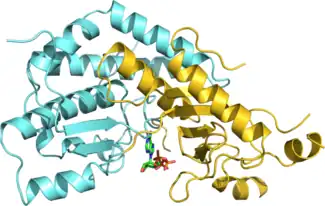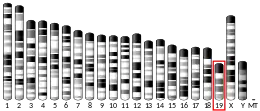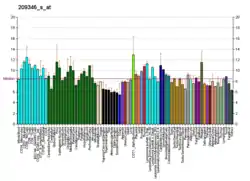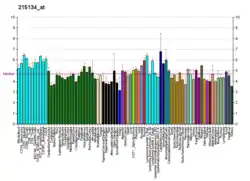Phosphatidylinositol 4-kinase 2-alpha is an enzyme that in humans is encoded by the PI4K2A gene.[5][6][7]
Classification
This gene encodes a phosphatidylinositol 4-kinase which catalyzes phosphorylation of phosphatidylinositol at the D-4 position, yielding phosphatidylinositol 4-phosphate (PI4P). Besides the fact, that PI4P serves as a precursor for other important phosphoinositides, such as phosphatidylinositol 4,5-bisphosphate, PI4P is an essential molecule in the cellular signaling and trafficking especially in the Golgi apparatus and the trans Golgi network.
Phosphatidylinositol 4-kinases are evolutionary conserved among eukaryotes and include four human isoforms
- phosphatidylinositol 4-kinase alpha (PI4KA)
- phosphatidylinositol 4-kinase beta (PI4KB)
- phosphatidylinositol 4-kinase 2-alpha (PI4K2A)
- phosphatidylinositol 4-kinase 2-beta (PI4K2B)
Function
Phosphatidylinositol 4-kinase 2-alpha (PI4K2A) is the most abundant phosphatidylinositol 4-kinase in human cells and is responsible for the synthesis of approximately 50% of the total PI4P within the cell. PI4K2A is associated mainly with the membranes of the trans Golgi network and early and late endosomes;[8] its membrane association is achieved by a heavy palmitoylation within a specific cysteine-rich motif.[9] Besides the synthesis of phosphatidylinositol 4,5-bisphosphate, PI4K2A is involved in various cell processes including membrane trafficking, regulation of endosomal sorting promoting target protein recruitment to endosomes or trans Golgi network, or signal transduction. Particularly, it regulates e.g. targeting of clathrin adaptor complexes to the Golgi apparatus,[10] EGFR signaling,[11] or the Wnt signaling pathway.[12]
PI4K2A is important in lysosomal quality control. It is the first essential enzyme of the phosphoinositide-initiated membrane tethering and lipid transport (PITT) pathway for rapid lysosomal repair.[13] Upon lysosomal membrane damage, PI4K2A is strongly recruited to lysosomes, leading to robust lysosomal PI4P production. Such lysosomal PI4K2A/PI4P signaling drives rapid lysosomal repair through extensive membrane contacts between the endoplasmic reticulum (ER) and damaged lysosomes as well as multiple ER-to-lysosomal lipid transfer processes.
Pi4k2a gene trap mouse show pre-mature aging and neurodegeneration, with increased lipofuscin accumulation.[14] PI4K2A-deleted patients have complex and severe developmental problems along with neurodegeneration.[15]
Clinical significance
Dysfunction of PI4K2A may contribute to tumour growth,[16] spastic paraplegia,[14] Gaucher's disease,[17] or Alzheimer's disease.[18]
Structure

PI4K2A is composed of a proline-rich N-terminal region and a kinase domain located C-terminally. The proline-rich N-terminal region contains physiologically important binding sites for a ubiquitin ligase Itch [20] and clathrin adaptor complex 3,[21] but is likely disordered and dispensable for the kinase activity.[22] The kinase domain can be divided into N-terminal and C-terminal lobes with the ATP binding groove and putative phosphatidylinositol binding pocket in between. The C-lobe of the kinase domain contains an additional lateral hydrophobic pocket with no distinct function assigned yet.[19][23]
References
- 1 2 3 GRCh38: Ensembl release 89: ENSG00000155252 - Ensembl, May 2017
- 1 2 3 GRCm38: Ensembl release 89: ENSMUSG00000025178 - Ensembl, May 2017
- ↑ "Human PubMed Reference:". National Center for Biotechnology Information, U.S. National Library of Medicine.
- ↑ "Mouse PubMed Reference:". National Center for Biotechnology Information, U.S. National Library of Medicine.
- ↑ Barylko B, Gerber SH, Binns DD, Grichine N, Khvotchev M, Südhof TC, Albanesi JP (March 2001). "A novel family of phosphatidylinositol 4-kinases conserved from yeast to humans". The Journal of Biological Chemistry. 276 (11): 7705–7708. doi:10.1074/jbc.C000861200. PMID 11244087.
- ↑ Minogue S, Anderson JS, Waugh MG, dos Santos M, Corless S, Cramer R, Hsuan JJ (May 2001). "Cloning of a human type II phosphatidylinositol 4-kinase reveals a novel lipid kinase family". The Journal of Biological Chemistry. 276 (20): 16635–16640. doi:10.1074/jbc.M100982200. PMID 11279162.
- ↑ "Entrez Gene: PI4KII phosphatidylinositol 4-kinase type II".
- ↑ Balla A, Tuymetova G, Barshishat M, Geiszt M, Balla T (May 2002). "Characterization of type II phosphatidylinositol 4-kinase isoforms reveals association of the enzymes with endosomal vesicular compartments". The Journal of Biological Chemistry. 277 (22): 20041–20050. doi:10.1074/jbc.m111807200. PMID 11923287.
- ↑ Barylko B, Mao YS, Wlodarski P, Jung G, Binns DD, Sun HQ, et al. (April 2009). "Palmitoylation controls the catalytic activity and subcellular distribution of phosphatidylinositol 4-kinase II{alpha}". The Journal of Biological Chemistry. 284 (15): 9994–10003. doi:10.1074/jbc.M900724200. PMC 2665123. PMID 19211550.
- ↑ Wang YJ, Wang J, Sun HQ, Martinez M, Sun YX, Macia E, et al. (August 2003). "Phosphatidylinositol 4 phosphate regulates targeting of clathrin adaptor AP-1 complexes to the Golgi". Cell. 114 (3): 299–310. doi:10.1016/s0092-8674(03)00603-2. PMID 12914695. S2CID 13281674.
- ↑ Minogue S, Waugh MG, De Matteis MA, Stephens DJ, Berditchevski F, Hsuan JJ (February 2006). "Phosphatidylinositol 4-kinase is required for endosomal trafficking and degradation of the EGF receptor". Journal of Cell Science. 119 (Pt 3): 571–581. doi:10.1242/jcs.02752. PMID 16443754.
- ↑ Pan W, Choi SC, Wang H, Qin Y, Volpicelli-Daley L, Swan L, et al. (September 2008). "Wnt3a-mediated formation of phosphatidylinositol 4,5-bisphosphate regulates LRP6 phosphorylation". Science. 321 (5894): 1350–1353. Bibcode:2008Sci...321.1350P. doi:10.1126/science.1160741. PMC 2532521. PMID 18772438.
- ↑ Tan JX, Finkel T (September 2022). "A phosphoinositide signalling pathway mediates rapid lysosomal repair". Nature. 609 (7928): 815–821. Bibcode:2022Natur.609..815T. doi:10.1038/s41586-022-05164-4. PMC 9450835. PMID 36071159.
- 1 2 Simons JP, Al-Shawi R, Minogue S, Waugh MG, Wiedemann C, Evangelou S, et al. (July 2009). "Loss of phosphatidylinositol 4-kinase 2alpha activity causes late onset degeneration of spinal cord axons". Proceedings of the National Academy of Sciences of the United States of America. 106 (28): 11535–11539. doi:10.1073/pnas.0903011106. PMC 2710652. PMID 19581584.
- ↑ Alkhater RA, Scherer SW, Minassian BA, Walker S (December 2018). "PI4K2A deficiency in an intellectual disability, epilepsy, myoclonus, akathisia syndrome". Annals of Clinical and Translational Neurology. 5 (12): 1617–1621. doi:10.1002/acn3.677. PMC 6292187. PMID 30564627.
- ↑ Li J, Lu Y, Zhang J, Kang H, Qin Z, Chen C (April 2010). "PI4KIIalpha is a novel regulator of tumor growth by its action on angiogenesis and HIF-1alpha regulation". Oncogene. 29 (17): 2550–2559. doi:10.1038/onc.2010.14. PMID 20154717.
- ↑ Jović M, Kean MJ, Szentpetery Z, Polevoy G, Gingras AC, Brill JA, Balla T (April 2012). "Two phosphatidylinositol 4-kinases control lysosomal delivery of the Gaucher disease enzyme, β-glucocerebrosidase". Molecular Biology of the Cell. 23 (8): 1533–1545. doi:10.1091/mbc.E11-06-0553. PMC 3327330. PMID 22337770.
- ↑ Wu B, Kitagawa K, Zhang NY, Liu B, Inagaki C (December 2004). "Pathophysiological concentrations of amyloid beta proteins directly inhibit rat brain and recombinant human type II phosphatidylinositol 4-kinase activity". Journal of Neurochemistry. 91 (5): 1164–1170. doi:10.1111/j.1471-4159.2004.02805.x. PMID 15569259. S2CID 36690417.
- 1 2 Baumlova A, Chalupska D, Róźycki B, Jovic M, Wisniewski E, Klima M, et al. (October 2014). "The crystal structure of the phosphatidylinositol 4-kinase IIα". EMBO Reports. 15 (10): 1085–1092. doi:10.15252/embr.201438841. PMC 4253849. PMID 25168678.
- ↑ Mössinger J, Wieffer M, Krause E, Freund C, Gerth F, Krauss M, Haucke V (December 2012). "Phosphatidylinositol 4-kinase IIα function at endosomes is regulated by the ubiquitin ligase Itch". EMBO Reports. 13 (12): 1087–1094. doi:10.1038/embor.2012.164. PMC 3512407. PMID 23146885.
- ↑ Craige B, Salazar G, Faundez V (April 2008). "Phosphatidylinositol-4-kinase type II alpha contains an AP-3-sorting motif and a kinase domain that are both required for endosome traffic". Molecular Biology of the Cell. 19 (4): 1415–1426. doi:10.1091/mbc.E07-12-1239. PMC 2291421. PMID 18256276.
- ↑ Barylko B, Wlodarski P, Binns DD, Gerber SH, Earnest S, Sudhof TC, et al. (November 2002). "Analysis of the catalytic domain of phosphatidylinositol 4-kinase type II". The Journal of Biological Chemistry. 277 (46): 44366–44375. doi:10.1074/jbc.m203241200. PMID 12215430.
- ↑ Zhou Q, Li J, Yu H, Zhai Y, Gao Z, Liu Y, et al. (March 2014). "Molecular insights into the membrane-associated phosphatidylinositol 4-kinase IIα". Nature Communications. 5: 3552. Bibcode:2014NatCo...5.3552Z. doi:10.1038/ncomms4552. PMC 3974213. PMID 24675427.
Further reading
- Balla A, Balla T (July 2006). "Phosphatidylinositol 4-kinases: old enzymes with emerging functions". Trends in Cell Biology. 16 (7): 351–361. doi:10.1016/j.tcb.2006.05.003. PMID 16793271.
- Balla T (July 2013). "Phosphoinositides: tiny lipids with giant impact on cell regulation". Physiological Reviews. 93 (3): 1019–1137. doi:10.1152/physrev.00028.2012. PMC 3962547. PMID 23899561.
- Minogue S, Waugh MG (2012). "The Phosphatidylinositol 4-Kinases: Don't Call it a Comeback". Phosphoinositides I: Enzymes of Synthesis and Degradation. Subcellular Biochemistry. Vol. 58. pp. 1–24. doi:10.1007/978-94-007-3012-0_1. ISBN 978-94-007-3011-3. PMID 22403072.
- Kutateladze TG (July 2010). "Translation of the phosphoinositide code by PI effectors". Nature Chemical Biology. 6 (7): 507–513. doi:10.1038/nchembio.390. PMC 3182472. PMID 20559318.
- Tan J, Brill JA (2014). "Cinderella story: PI4P goes from precursor to key signaling molecule". Critical Reviews in Biochemistry and Molecular Biology. 49 (1): 33–58. doi:10.3109/10409238.2013.853024. PMID 24219382. S2CID 207506490.






